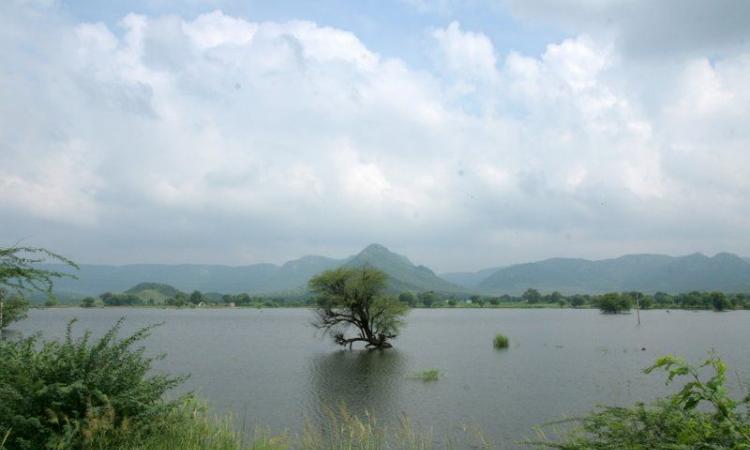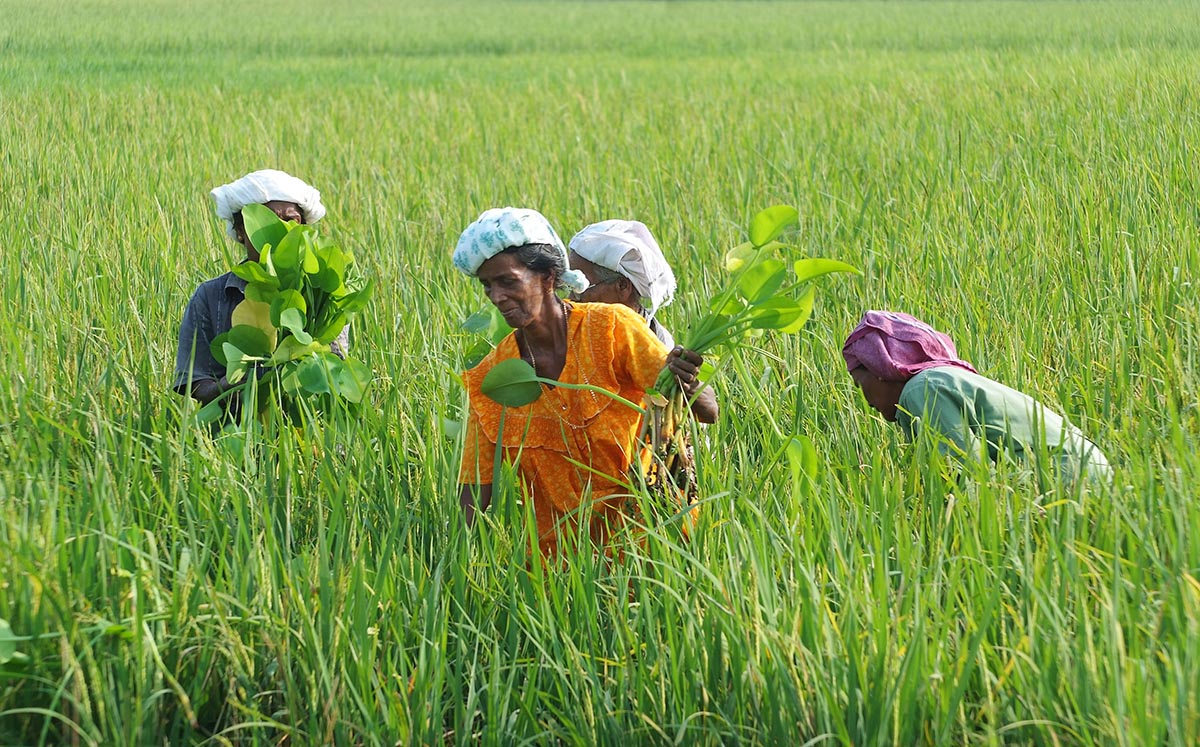
The exodus of migrant workers from urban areas back to their villages in the wake of country wide lockdown has brought rural poverty into sharp focus. Reconstruction of rural economy therefore needs policy and planning attention. Community economy is a branch of rural economy and among other ways of reconstructing the rural economy, promotion and strengthening of community economies of the poor is important.
Livelihood of rural poor based on ecological resources of land, water and forest hinges on their sustainable use and equitable distribution. Community economies function on the basis of community resources, community ownership and community management. Community economies are subsistence economies of the poor. However, when promoted through rights, resources, participation and innovations, people can turn their subsistence economy into a profitable one.
Community economies save the poor from food scarcity, hunger, malnutrition, indebtedness and migration. In doing so, they not only bestow dignity on the most deprived population, they also promote distributive justice that encompasses access to resources, livelihood and food.
The state has an enormous presence in community economies as it promotes such economies as a strategy for poverty eradication. The state sponsored programmes on poverty reduction have a natural resource management component. Besides, community economies based on ecological resources are also promoted by individuals and NGOs. There are many examples of successful community economies. Four such cases are discussed below briefly. The cases not only point out the potential of such economies, they also provide a template for their implementation.
Water equity at Sukhomajiri
It is worth recalling the success of Sukhomajiri watershed management in the 1970s. Sukhomajiri at that time was a hamlet of Gujjars (shepherds) in the lower Shivalik hill in Haryana. People owned small pieces of land, between one to two hectares, some even less than one hectare. There was crop failure due to lack of irrigation and erratic rainfall. Migration for work was widespread. There was heavy dependence on forests; uncontrolled grazing and felling of trees were rampant.
In 1976 the Central Soil and Water Conservation Research and Training Institute began soil and water conservation in Sukhomajiri. In the beginning they faced resistance from people as grazing was not allowed in the catchment area. The situation turned around in the next year when there was drought and crop failure; only crops close to the earthen dam built for moisture conservation was saved by using the water stored in the reservoir. A second dam was built in 1978 and underground pipes were laid to take water to fields for irrigation. The next year was again a drought year and the water from the reservoirs saved the crops.
To make the water resources equitable, Sukhomajiri people formed a water user association that later became the Hill Resource Management Society (HRMC). The association formed rules for water distribution. People would get water for a payment; landless or those having small holdings could sell their share of water. People’s participation and equity in water distribution led to cooperation in managing water and forest resources. People adopted social fencing and refrained from grazing in the catchment area leading to greening of denuded areas.
Economic condition of people improved with increase in crop production, namely wheat and maize. People purchased buffalos instead of goats and this led to increase in milk production. Migration from Sukhomajiri was reduced. Sukhomajiri got a permit from the forest department in 1985 to cut grass from the forest in return for royalty to the forest department. The HRMC charged villagers a fee. This was beneficial to the village as instead of paying to the contractor, the money was used in enhancing the resources in the community. People planted more grass in the catchment area. A particular kind of grass known as Bhabbar used in rope and paper became a profitable enterprise for the village.
Collective farming by women in Kerala

Sangha Krishi, literally meaning group farming, is practiced by landless women in Kerala villages. It was initiated in 2007 under the poverty eradication programme of the Government of Kerala. Large numbers of landless wage labours pursue collective farming under Sangha Krishi. Women lease wasteland and fallow land, improve soil quality, and cultivate a variety of crops and vegetables. The yield from the land is either sold in the market or taken home when there is a shortage of food for family.
The women farmers belong to women’s collectives called Kudumbashree, formed under the ‘People’s Plan’ in 1998. As Kudumbashree members, the women farmers pursuing Sangha Krishi are part of the three-tier structure that comprises: a Neighbourhood Group (NHG) at the village level, an Area Development Society (ADS) which is a federation of NHGs at the ward level and a Community Development Society (CDS) which is a federation of ADSs at the panchayat level. As parts of a state-led programme, Sangha Krishi is facilitated and monitored by the state agencies.
Despite having a public distribution system for food, the rural poor suffer from hunger, food scarcity and malnutrition. In such situations, an initiative like Sangha Krishi provides food security to a family as well as to a community. At another level, it turns landless women, majority of who work as agriculture labour, into farmers. Even though the landless women don’t become landowners, in an economic and social setting where poor women struggle to earn livelihood, Sangha Krishi provides them dignity of livelihood.
Community based forest management at Panchgaon
Pachgaon, a predominantly tribal village in Gondpipri taluka of Chandrapur district of Maharashtra, illustrates how community forestry can be managed prudently by the poor and forest–based livelihoods can be planned with concerns for ecology and equity. Only a few households of Pachgaon practiced cultivation; remaining households were heavily dependent on wage labour. There was high dependent on forest produce. As earning livelihoods became increasingly difficult, people faced the inevitable fate of migration. It was in this situation that the gram sabha of Pachgaon pursued getting Community Forest Rights (CFR) under the Forest Right Act 2006 even though it was not an easy task. A total forest area of 2486.90 acre of forest land was granted to the Pachgaon gram sabha in 2012 as community forest.
People together with the gram panchayat evolved a community plan to manage and use the forests sustainably for a variety of purposes such as bamboo harvest, fuel, fodder and livestock grazing. Bamboo was harvested by following a rotational method, by dividing the forest area into three zones, and bamboo was cut in each zone once in three years, giving sufficient time for the plantation to grow. The gram sabha formed rules and regulations for the management of community forest.
Bamboo harvesting generated employment for the villagers. The gram sabha auctioned bamboo. The wages were paid from the sale of bamboo and the surplus was invested in the community forest and development of the village. Land adjacent to the village was purchased to make a shed for the storage of NTFPs (Non Timber Forest Produce). In three years, the gram sabha earned INR 1 crore from the sale of bamboo and every household on an average earned INR 20,000 from the community forest.
Reviving traditional water harvesting systems in Rajasthan
Johad is a traditional rainwater harvesting system in Rajasthan. Johads are a system of earthen check dams that arrest runoff leading to improvement in percolation and groundwater recharge. The water collected in a johad during the monsoon is used for irrigation, drinking, and for other domestic purposes. Johads improve the soil moisture in the fields and as a result they can help in cultivating a second crop in winter.
Rajendra Singh and his organization, Tarun Bharat Sangh, a grassroots organization based in Thanagazi block in Alwar district, began reviving the traditional practices of johad with community support. It began its work in Gopalpura village in 1985 and in 25 years it built close to 10,000 water harvesting structures in 1,000 villages spread over 15 districts in Rajasthan.
TBS has constructed johads on agricultural land as well as on village common land (gochar). They have been constructed by using local knowledge, local resources and locally available technology. Modern technology is used in a limited manner, only when required. Cost of construction is shared by people who benefit from johads.
Jal Samiti (water committee) and Jal Sabha (water assembly) are two community based collectives constituted by TBS to help in planning, construction and maintenance of johads. They are also responsible for including the land belonging to all social groups while planning johads. Johads constructed by TBS have resulted in an increase in groundwater level; they have resulted in sustained increase in crops, increase in household income from agriculture and animal husbandry, and have substantially reduced migration to other regions for work.
The revival of the traditional practices of johad has led to its inclusion in state-sponsored projects; the National Rural Employment Guarantee Scheme has incorporated construction of johads under its asset building component in Rajasthan.
Need to strengthen community economies
The cases described above show that community resources are the key resources that the poor protect, harness and use in a community economy. Collective management, participation and equity are the foundations on which community economies are sustained. Community economies revive local indigenous knowledge and traditional wisdom including traditional technologies. They do not discard modern information, knowledge and technologies altogether; they use them selectively. Community economies conserve, respect and make prudent use of ecological resources. As the survival of the poor depends on the ecological resources of land, water and forest, community economies have positive impact on ecology as they strive towards sustainability, biodiversity, and climate justice.
Community economies face the threat from excessive state control, conflict between people and government agencies, social conflicts, and encroachment on community resources by external agencies for growth and profit ventures. The state has a responsibility to facilitate community economies as a shared goal with the rural poor than exercise control. Community economies that are participatory and decentralized, that address and resolve conflicts, and ensure the values of egalitarianism and equity become sustainable.
Ranjita Mohanty is a Sociologist and author of the book Democratizing Development: Struggles for Rights and Social Justice in India (Sage, 2018).